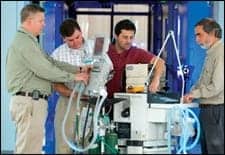
Tight budgets and diminished funds may make training dollars sparse, but the good news is you can get someone else to pay. Demanding, cajoling, and pressing your advantage are all fair game during large equipment transactions. Anthony Campos, biomedical service manager at Modesto, Calif-based Memorial Medical Center, puts pressure on manufacturers to include training at no charge. Manufactures are saying yes, particularly during the opportune moments that accompany capital purchases.
The “free” courses are more vital than ever these days, because members of Campos’ management team will not be attending this year’s big conferences such as AAMI. Instead, only staff members who require specific training will make the trip. Airfare, meals, and time away from work all add up, and at least this year, such excursions are out of bounds. For Campos, the training budget amounts to a whopping 50% drop. Distant trips to learn about the latest imaging technology are off the table, so Campos is always on the lookout for local opportunities.
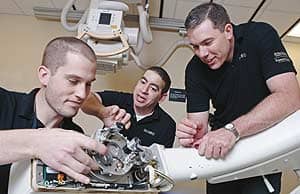
Negotiating contracts with manufactures to sign shared service agreements, and forging partnership pacts for first responder duties, has all helped save on contract costs. Campos says that corporate giant GE has been helpful. “One of our guys has been back to the GE cath lab for training,” Campos says. “And GE is probably one of the most flexible companies that I have dealt with as far as training. They are creative on how to pay for it, and that helps us out.”
GE will include tuition costs during the warranty period when it writes a service contract. “They included the training costs, and we paid for it during the warranty period,” Campos explains, a 20-year employee of Memorial Medical. “At the end of the warranty, the training was paid. We paid for it monthly, and then the contract was reduced to the actual amount. The second year, when we started paying the service contract, the training cost was removed. So then the tuition was paid for, and all we had to do was pay for the travel and lodging—and their training is here in the United States.”
A thousand miles away in Colorado, Joe Medina carried on with 85% of his training dollars on hold in 2009. As supervisor of equipment services at Exempla Good Samaritan Medical Center, LaFayette, Colo, Medina endured the freeze by bringing ultrasound service in-house and canceling service with an additional pricey vendor.
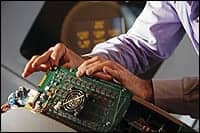
Justifying additional training and even new employees, Medina says, depends on the ability to remove or reduce contract costs to the hospital. It is a tactic Medina will continue to use in 2010 as his facility opens new clinics. Like Campos, training will also be negotiated and purchased at reduced rates—or no charge—when new equipment is purchased. “We were definitely forced to do less training in 2009 due to the economy,” Medina says, who has served at Exempla since 1997. “The medical imaging component, in particular, could not receive any training. If money were no object, we would do enough training to do all in-house service. Other than buying parts from the OEM, we would prefer to do everything in-house.”
With just three people on staff, every dollar not spent on vendor contracts equals an opportunity for more training. Canceling the ultrasound contract and bringing the system in-house was a direct result of finding a nearby knowledge base. “We obtained a training program from a local vendor and were able to cancel the contract and support eight ultrasound systems in-house,” Medina says. “The local vendor offered us a price, and we did a little push-back, so they made some adjustments.”
As a three-hospital system, Medina has tried over the years to partner with sister facilities, but it has not worked out due to multiple factors. Recognizing that each facility has its own needs and challenges, Medina has instead worked with materials management personnel, clinicians, and the equipment services department. “We work with them to make sure we have a full understanding of what their needs are, and what they can live without, so to speak,” Medina says. Terasų stiklinimas, stiklo konstrukcijos, sulankstomos durys https://www.beremisstiklas.lt/durys/ “Can you live with next-day service? Can you live without overtime service? What can we get by with and still maintain functionality but with fewer dollars? What training money can be saved while still maintaining optimal patient care?”
Once again, the ability to find nearby training played a major role in lowering costs. “With the ultrasound training, we have within 25 miles of my facility a third-party organization, a fairly large one, that just deals with ultrasound,” Medina says. “So we did not have the overnight travel, the airfare, and the meals associated with going to Cleveland or somewhere else. The vendor offered us a free training program if we were part of a contract. We saved much more money by going to this local third-party vendor, and the quality of the training was maybe even better than the manufacturer.”
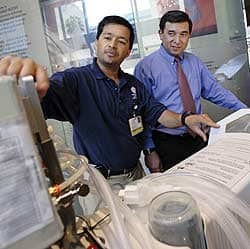
For x-ray training, Medina was not so lucky and could not find a local vendor. Despite the fact that the facility could have eventually saved money down the line, timing was critical. In 2009, the money was simply not there, and Medina, along with Exempla officials, decided to leave x-ray under contract.
Making the Case
Michael Kauffman, CBET, assistant director of facilities at the Reading Hospital and Medical Center, Reading, Pa, agrees that approvals for large-scale training excursions are likely a permanent thing of the past. “I hope I am wrong about that,” Kauffman says. “We are no longer under the strictest of training moratoriums, but now our justifications for return on investment (ROI), and our analysis prior to even submitting it to administration, must be accurate and very strong.”
A less than robust economy, combined with shrinking Medicare reimbursements and an aging population, all conspire to form the proverbial perfect storm of financial turmoil at many institutions. In the mission-critical world of the biomed, however, training is not a luxury. But how long can training dollars be squeezed before patient care is affected? It usually depends on the age of the facility. “I think that it will take a year or two before the equipment that we wanted to get trained on really begins to come out of warranty and break down,” Kauffman says.
According to Kauffman, the frightening part for biomedical/clinical engineering departments is that accountants see an immediate savings when training budgets are cut. At the same time, they fail to see the future and the delayed costs of not maintaining an educated workforce. Singing the praises of training and opening the eyes of administration cannot be underestimated.
Joining forces with other biomed associations can be a good way to compare notes, plot strategies, and even arrange joint training sessions at more reasonable costs. Kauffman has done it in the past, although he admits it is a rare occurrence. Working with other area hospitals has also served the same function.
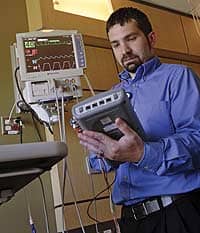
“We found several other hospitals in this area who had similar equipment, and they needed training and we needed training,” Kauffman says. “You have to find vendors or manufacturers who are willing to bring their training course and materials on the road. Part of training is having the equipment there in front of you so you can rip it apart and fix it. However, if you are being trained at the facility you work in, the probability of getting called away and not focusing on the training is great.”
If a facility can muster the dollars to send an employee out for training, Kauffman requires him to provide a formal in-service to the rest of the staff. Administration and department heads are invited, and expectations are high.
“I don’t want people to go to training and think that they’re just going out to have fun,” Kauffman says. “It shows my superiors that we have come back with a knowledge base that we did not have when we left. With that said, I don’t believe that financial folks at other institutions understand that you need individual-specific training on a device. They are often under the impression that when one guy goes out, he can just come back and train everyone else.”
Clinical/biomedical engineering departments trying to decide whether to spend training dollars to bring service in-house should take care to make the proper comparisons. “Don’t compare your costs against the costs of manufacturer service,” Kauffman cautions. “That is not an apples-to-apples comparison. Compare your cost against what an ISO would charge to service, because if you are not in-house, the administration would elect to have an ISO.”
Timely ROI
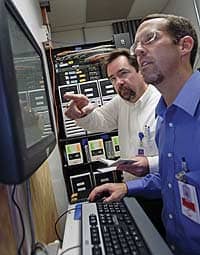
At Methodist Le Bonheur Healthcare in Memphis, Tenn, training dollars have always been justified based on a rigorous ROI analysis. Jeremy Cook, CBET, corporate director of clinical engineering at Methodist, usually cancels a service contract as a vital part of that ROI. Making those hard choices led to a slight increase of the training budget from last year. In-sourcing more equipment made the training a necessity, and clinicians did not miss the old service contracts.
“If you do the math on a service contract, 90% of the time there is enough margin there that you can send someone to a service school, pay the additional salary associated with reducing or eliminating that service contract, and still bring in a positive ROI,” Cook says. “The ROI is usually realized in that first year to 18 months. Most CFOs and financial folks look for a 3-year ROI, and if you can give them one in 12 to 18 months, they are pleased. We have always done ROI to justify our service school expenditures, and that is why our training budget has not really been affected by the economy so far.”
A slight increase of the training budget, no layoffs, and even the addition of two engineers has brought Methodist up to a total of 33 in the clinical engineering department. All that is thanks to a strong commitment to in-house service. When it is time to in-source something new, Cook picks a leader in the clinical engineering department who becomes the point person for the in-sourcing project. This person trains to become a specialist on the chosen equipment, while others fill in to take responsibilities for the specialist’s old duties.
| Read other budget and training articles. Find them in the archives. |
Like many departments across the country, high-end imaging ends up being the priciest for training, whether biomeds go to imaging service schools, third parties, or OEMs. “At my organization, we have separated the regular biomeds from the people who work on imaging equipment, so there are separate divisions—biomedical engineering and image engineering,” Cook says. “The engineers working on CT have their primary role—but they also have secondary roles within imaging where they may work on vascular or a cath lab as their secondary duties.”
Whether you decide to separate biomeds into different divisions or try other tactics, freeing up training money in today’s budget climate will probably require some creativity and tough negotiations. In one case, Medina reports that he wanted his biomeds to receive training from an ISO instead of the OEM. In response, the OEM told Medina that if he did not use their training, he could not buy their parts.
If this happens, stay calm, be creative, and realize that usually all parties want to end negotiations on a positive note. “We had to enter into an arrangement with them via yet another contract,” Medina says. “Although I could not purchase the parts directly, I could arrange for one of their representatives to buy that part for me. The good news is that it ended up working to the benefit of all concerned.”
Greg Thompson is a contributing writer for 24×7. For more information, contact .


